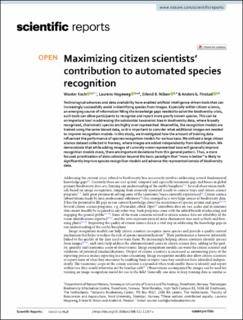| dc.contributor.author | Koch, Wouter | |
| dc.contributor.author | Hogeweg, Laurens | |
| dc.contributor.author | Nilsen, Erlend Birkeland | |
| dc.contributor.author | Finstad, Anders Gravbrøt | |
| dc.date.accessioned | 2023-02-07T12:12:03Z | |
| dc.date.available | 2023-02-07T12:12:03Z | |
| dc.date.created | 2022-05-11T13:04:18Z | |
| dc.date.issued | 2022 | |
| dc.identifier.citation | Scientific Reports. 2022, 12 (1), . | en_US |
| dc.identifier.issn | 2045-2322 | |
| dc.identifier.uri | https://hdl.handle.net/11250/3048877 | |
| dc.description.abstract | Technological advances and data availability have enabled artificial intelligence-driven tools that can increasingly successfully assist in identifying species from images. Especially within citizen science, an emerging source of information filling the knowledge gaps needed to solve the biodiversity crisis, such tools can allow participants to recognize and report more poorly known species. This can be an important tool in addressing the substantial taxonomic bias in biodiversity data, where broadly recognized, charismatic species are highly over-represented. Meanwhile, the recognition models are trained using the same biased data, so it is important to consider what additional images are needed to improve recognition models. In this study, we investigated how the amount of training data influenced the performance of species recognition models for various taxa. We utilized a large citizen science dataset collected in Norway, where images are added independently from identification. We demonstrate that while adding images of currently under-represented taxa will generally improve recognition models more, there are important deviations from this general pattern. Thus, a more focused prioritization of data collection beyond the basic paradigm that “more is better” is likely to significantly improve species recognition models and advance the representativeness of biodiversity data. | en_US |
| dc.language.iso | eng | en_US |
| dc.publisher | Nature | en_US |
| dc.rights | Navngivelse 4.0 Internasjonal | * |
| dc.rights.uri | http://creativecommons.org/licenses/by/4.0/deed.no | * |
| dc.title | Maximizing citizen scientists’ contribution to automated species recognition | en_US |
| dc.title.alternative | Maximizing citizen scientists’ contribution to automated species recognition | en_US |
| dc.type | Peer reviewed | en_US |
| dc.type | Journal article | en_US |
| dc.description.version | publishedVersion | en_US |
| dc.source.pagenumber | 10 | en_US |
| dc.source.volume | 12 | en_US |
| dc.source.journal | Scientific Reports | en_US |
| dc.source.issue | 1 | en_US |
| dc.identifier.doi | 10.1038/s41598-022-11257-x | |
| dc.identifier.cristin | 2023532 | |
| cristin.ispublished | true | |
| cristin.fulltext | original | |
| cristin.qualitycode | 1 | |

